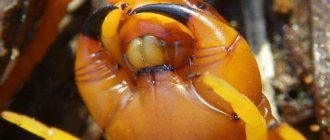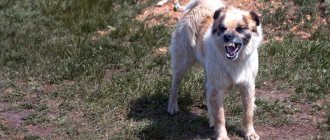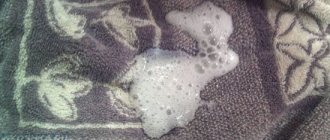- Wild animals
- >>
- Insects
Scolopendra is a fast-moving predatory insect. It is widespread throughout the planet; its favorite habitats are damp and cool places. A comfortable time of day for her is night. Dexterity and speed help the scolopendra to obtain food for itself, which it constantly requires.
Origin of the species and description
Photo: Scolopendra
Scolopendra is an insect from the genus of tracheal arthropods. There are a huge number of varieties of scolopendra, and some species have not been studied to this day. The centipede can live both in wild conditions, forests and caves, and in domestic ones. The inhabitants of the house are also called flycatchers. It does not cause harm to the owners of the house, but helps get rid of other annoying insects.
Video: Scolopendra
The centipede is a representative of the most ancient insects on the planet. This insect evolved into the form it has now many years ago. Scientists have discovered a fossilized specimen that lived 428 million years ago. During molecular analysis, scientists found that the separation of the main groups of centipedes occurred back in the Cambrian period. According to the latest research conducted in 2005, P. newmani was the oldest animal discovered.
Compared to other insects, scolopendras are long-lived, some individuals live up to 7 years. Although on average an individual lives for two years. The growth of the insect continues throughout its life, although in some individuals growth ends at puberty. The main uniqueness of scolopendra is the regeneration of limbs. Lost paws grow back after molting, but may differ in size, new limbs are shorter than the previous ones and weaker.
Relationships with a person
Having seen this creature in their apartment, quite a lot of people wonder why the domestic scolopendra is dangerous. In fact, these unpleasant-looking individuals are considered useful in some way. Thanks to their ability to kill insects, they can help you get rid of many pests.
On a note! By the way, the taste preferences of the flycatcher in most cases make it clear why it chose your home!
If we talk about whether the domestic scolopendra is dangerous for humans, then it is not capable of causing much harm. Living in residential areas, these creatures will feed exclusively on insects or small arthropods, without touching plants, food supplies, furniture, or wallpaper.
Since the flycatcher's jaws are quite weak, it is not capable of biting through our skin. And if she manages to do this, then there will be no particular harm - the concentration of the poison is too low, not only for humans, but also for pets. In addition, they bite extremely rarely and exclusively for the purpose of self-defense.
Appearance and features
Photo: What scolopendra looks like
Scolopendra has a soft body; the main component of the exoskeleton is chitin. Therefore, like other invertebrates, it molts, shedding its shell as it grows. Thus, a young individual changes its “clothes” once every two months, an adult – twice a year.
Centipedes vary in size. Typically the body length is 6 cm, but there are species whose length is 30 cm. The body of the scolopendra is divided into the head and torso and has about 20 segments (from 21 to 23). The first two segments are colored in a color that differs from the main color of the centipede, and do not have. The ends of the limbs are a spike. The limb contains a gland with poison.
Interesting fact: If a scolopendra runs across the human body, it will leave a slippery and burning trail.
The head of the centipede is composed of one plate, on which there are eyes, two antennae and poisonous jaws, with the help of which it attacks prey. All other segments of the body have a pair of limbs. The centipede uses its last pair of legs for reproduction and hunting for large prey. They serve as her anchor.
The color of the centipede varies: from different shades of brown to green. There are also purple and blue individuals. The color of an insect does not depend on the species. Scolopendra changes colors depending on the age and climate in which it lives.
What to do if bitten?
The ideal option is to not allow the centipede to touch the skin, but this does not always work. In the event of a bite or touching, you must:
- Wash the inflamed area of the skin with soap and water.
- Treat it with alcohol or other disinfectant solution.
- Apply a sterile bandage to the wound.
- Remove the dressing and replace it with a clean one after 12 hours.
A victim of a poisonous arthropod should drink a lot, give up alcoholic beverages, exercise and nervous tension.
If a scolopendra stings a pregnant woman, a child, an elderly person, a person prone to allergies or suffering from heart disease, it is necessary to urgently take the patient to the hospital. There he will receive qualified assistance. Delay can have irreversible consequences.
Where does scolopendra live?
Photo: Crimean scolopendra
Scolopendra can be found in all climatic regions. However, their population is especially expanded in places with warm climates: tropical forests of Central and South America, in the equatorial part of Africa, in southern Europe and Asia. Giant centipedes live only in tropical climates; their favorite place is the Seychelles. Centipedes live in forests, on mountain peaks, in dry, hot deserts, and in rocky caves. Individuals that live in regions with temperate climates do not grow large in size.
Interesting fact: It will not be possible to meet a giant scolopendra in our regions, since only small representatives of this species of arthropod live here.
Scolopendras prefer night life because they do not like bright light. They can't stand the heat, although they don't like rain either. Whenever possible, they choose people's houses as their homes. Here they can most often be found in a dark, damp basement.
In their natural environment, centipedes live in moist, dark places, most often in the shade under foliage. Ideal places for centipedes to exist are rotting tree trunks, litter of fallen leaves, the bark of old trees, crevices in rocks, and caves. During the cold season, centipedes take refuge in warm places.
Now you know where scolopendra is found. Let's see what this insect eats.
Premises prevention
In order not to agonize over the question of how to deal with centipedes, simply follow the recommendations given below, and the chances of centipedes appearing in your apartment will be minimal.
- Ventilate the room regularly.
- Make sure there is plenty of light in the room (scolopendras do not like light).
- Get rid of clutter in attics and basements. In things that have been lying around for years, moisture accumulates, in which centipedes feel comfortable.
- Seal all cracks in the house and apartment with sealant. Place mosquito nets on ventilation shafts.
- Ventilate the basement.
By following all the recommendations and advice given in this article, you will be ensured a normal existence in your apartment or house.
What does scolopendra eat?
Photo: Centipede insect
The centipede naturally has anatomical adaptations with which it successfully copes with catching prey:
- maxillomandibles;
- wide throat;
- poison glands;
- tenacious legs.
The centipede is a predator. When attacking prey, the scolopendra first immobilizes the victim and then slowly eats it. The likelihood of prey escaping from a centipede is very low, because not only does it move very quickly, it also makes attacking jumps.
Interesting fact: Scolopendra can move at speeds of up to 40 cm per second.
Advantages of centipedes when hunting prey:
- has good vertical running skills;
- the insect is very dexterous and agile;
- has a quick response to any vibrations in the air;
- at one time an individual can catch several victims at once.
Domestic scolopendras are flycatchers; they eat any insects: cockroaches, flies, mosquitoes, ants, bedbugs. Therefore, the flycatcher benefits the house in which it lives.
Forest scolopendras give preference to living creatures that live underground: earthworms, larvae, beetles. When it gets dark and the scolopendra comes out of its hiding place, it can hunt for grasshoppers, caterpillars, crickets, wasps and ants. Scolopendra is very voracious, she needs to constantly hunt. When hungry she becomes very aggressive. Large scolopendra also attacks small rodents: snakes, lizards, chicks and bats.
Why do they appear in the house?
There are two reasons why scolopendras may appear in the house:
- optimal living conditions (when it is warm and dry outside, and the houses are humid and damp);
- availability of food.
Centipedes often appear in those houses and apartments where there are basements, because it is always dark and high humidity. From there, in search of food, insects can climb into houses through cracks, and into apartments through pipes.
If a scolopendra is noticed in the house, then you should carefully inspect the home, since, most likely, the centipede came here in search of food. She usually hunts cockroaches, spiders and bedbugs.
Features of character and lifestyle
Photo: Scolopendra in the Krasnodar region
Scolopendra is a poisonous predatory insect that is a dangerous enemy for many insects and small animals. By biting its victim, the scolopendra paralyzes it with poison and slowly eats it. Since the centipede is active at night, it is more productive to hunt at this time of day. During daylight hours, the scolopendra itself hides from enemies so as not to become lunch for others, although during the day it is also not averse to feasting on it.
Centipedes prefer an antisocial life, so they live alone. The centipede shows aggression towards its relative extremely rarely, but if there is a fight between two individuals, one of them dies in any case. In relation to the surrounding world, scolopendra, as a rule, does not show friendliness. This is a nervous and angry insect, whose anxiety is caused by its eyes’ sensitive perception of the light and colors of the surrounding world.
Therefore, any animal or insect that disturbs the scolopendra automatically becomes its target for attack. It is almost impossible to escape from a centipede because it is very fast and agile. In addition, the centipede's digestive system, which digests food very quickly, requires constant replenishment of food supplies. Because of this, the scolopendra constantly needs to look for food.
Interesting fact: The Chinese scolopendra digests slightly less than half of its dinner within three hours.
Lifestyle
Author: Eran Finkle /
Like most predators in nature, they prefer to live separately. Large families are not about them. It is quite difficult to meet her during the day, as she is a night hunter.
They are distinguished by an aggressive, nervous disposition, but they attack only for self-defense. They see poorly, and therefore behave very carefully. They are quite voracious and constantly chew something. Madagascar or Thai varieties easily cope with bats. They easily digest lunch in three hours, since they have a primitive digestive system.
5
Social structure and reproduction
Photo: Black centipede
Scolopendras become sexually mature in the second year of life. They begin to reproduce in mid-spring and do not finish throughout the summer. After the mating process has passed, after a couple of weeks the female begins to lay eggs. The ideal place for laying eggs is considered damp and warm. On average, a female produces from 40 to 120 eggs per clutch, but not all survive. Females monitor and take care of their clutches, covering them from danger with their paws. After the ripening period, small worms are born from the eggs.
At birth, baby centipedes have only four pairs of legs. With each molting process, the little scolopendra adds paws. Until a certain age, the mother remains close to the offspring. But baby centipedes very quickly adapt to their environment and begin to live independently. Compared to other invertebrate representatives, invertebrates are truly long-livers. Their average life expectancy is 6 – 7 years.
There are three stages of development and maturation of centipedes:
- embryo. A stage whose duration lasts one or one and a half months;
- nymph. This stage also lasts from one to one and a half months;
- juvenile The stage reached by the little scolopendra after the third molt;
- Over time, the color of the head changes to a darker color, and the plate becomes easily distinguishable from the body. Young scolopendras begin to live independently at the end of the third week. The scolopendra becomes fully mature only in the second or fourth year of life.
The development of centipedes and its speed depends on climatic conditions, nutrition, humidity and temperature. Each type of centipede has its own life expectancy. Once mature, individuals, depending on the species, can live from two to seven years.
Natural enemies of centipedes
Photo: What scolopendra looks like
In their natural habitat, scolopendras are also hunted by predators. At the same time, the diversity of species that eat centipedes is relatively small. The most dangerous natural enemies of the centipede are frogs, toads, small mammals (shrews, mice), and birds. Owls love to hunt centipedes. Also, scolopendra is a nutritious protein food.
Pets such as dogs and cats also eat flycatchers. But this can carry a certain danger, since parasites often live inside centipedes. When an animal eats a scolopendra infected with the parasite, it also automatically becomes infectious. Scolopendras are a tasty morsel for snakes and rats.
Interesting fact: A large scolopendra can eat a smaller scolopendra.
Some peoples to this day consider scolopendra as a tasty and healthy food, because its body contains a lot of protein. In certain cultures, there is a belief that centipedes, as food, cure many diseases that are incurable with drugs.
Traditional medicine does not recommend eating scolopendra as food for people, especially in its raw form, because most individuals on the planet are infected with parasites. A dangerous parasite that lives in the body of a centipede is the rat lungworm. This parasite causes a dangerous disease that leads not only to incurable neuralgic diseases, but even to death.











